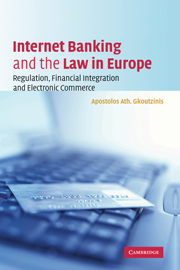Book contents
- Frontmatter
- Contents
- Tables
- Preface
- Tables of legislation
- Table of EU legislation
- Table of international conventions
- Table of cases
- Abbreviations
- Introduction
- PART I Introduction to electronic finance and Internet banking
- PART II Online banking and international market access: The causes of incomplete financial integration and what to do about them
- PART III EU harmonization and convergence of national laws relating to electronic banking activities
- 5 Risks and regulatory concerns relating to electronic banking activities and the convergence of national prudential regulatory standards
- 6 EU measures of legal harmonization concerning electronic commerce and distance marketing of financial services, data protection, banking contracts and investor protection
- PART IV Applicable law and allocation of regulatory responsibility in cross-border electronic banking activities
- Conclusions
- Select bibliography
- Index
5 - Risks and regulatory concerns relating to electronic banking activities and the convergence of national prudential regulatory standards
Published online by Cambridge University Press: 11 August 2009
- Frontmatter
- Contents
- Tables
- Preface
- Tables of legislation
- Table of EU legislation
- Table of international conventions
- Table of cases
- Abbreviations
- Introduction
- PART I Introduction to electronic finance and Internet banking
- PART II Online banking and international market access: The causes of incomplete financial integration and what to do about them
- PART III EU harmonization and convergence of national laws relating to electronic banking activities
- 5 Risks and regulatory concerns relating to electronic banking activities and the convergence of national prudential regulatory standards
- 6 EU measures of legal harmonization concerning electronic commerce and distance marketing of financial services, data protection, banking contracts and investor protection
- PART IV Applicable law and allocation of regulatory responsibility in cross-border electronic banking activities
- Conclusions
- Select bibliography
- Index
Summary
In the previous chapter I argued that online banks providing services across borders should be subject to the mandatory law of the country in which they are established and be free to select the law governing their contracts provided that a minimum level of convergence in national prudential standards, consumer and investor protection rules has been attained. This chapter is descriptive rather than normative and aims to discuss the legal harmonization of prudential regulatory standards in the European Union with particular regard to the special risks and regulatory interests relating to electronic banking activities.
The discussion begins with the jurisprudence of the European Court of Justice (‘the Court’) concerning the regulatory interests that the ‘host country’ may invoke to justify restrictions on the free movement of services. It is perhaps useful to understand which national regulatory objectives, and under which conditions, justify derogations from the principle of mutual recognition because this information could be determinative of what needs to be harmonized prior to accepting mutual recognition of national laws and regulatory practices.
Convergence of national laws and the notion of ‘general good’ in the single European market
The judicial concept of the ‘general good’ is the key to unlock the normative elements of mutual recognition and, perhaps, to understand the required scope of legal harmonization prior to establishing a pure form of mutual recognition.
- Type
- Chapter
- Information
- Internet Banking and the Law in EuropeRegulation, Financial Integration and Electronic Commerce, pp. 137 - 164Publisher: Cambridge University PressPrint publication year: 2006



